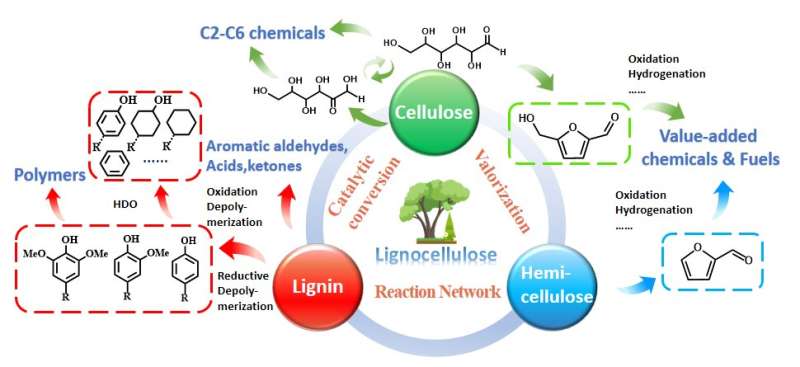This article has been reviewed according to Science X's editorial process and policies. Editors have highlighted the following attributes while ensuring the content's credibility:
fact-checked
proofread
A panoramic view of the catalytic conversion network for lignocellulosic biomass valorization

Fossil fuel consumption contributes to significant greenhouse gas emissions and severe climate issues. It is imperative to explore sustainable alternatives to the current industrial production of chemicals and fuels. The efficient utilization of lignocellulosic biomass as a substitute for fossil resources is a promising approach to promote the sustainable development of modern society.
Although numerous valorization routes for lignocellulose have been explored, large-scale lignocellulose valorizations are still limited. In this regard, a group of researchers has summarized the catalytic reaction routes, reaction types, and key steps for the selective preparation of various important products from lignocellulose with four panoramic reaction network maps.
They also point out the challenges and possible resolving strategies in the lignocellulose valorization processes. This could provide a panoramic view of the related field and facilitate the development of sustainable and efficient lignocellulose-based biorefineries. This review was published in Industrial Chemistry & Materials.
"The valorization of lignocellulose for the production of chemicals or fuels has been the subject of extensive research, which has been comprehensively reviewed by numerous scholars with expertise in the field," said corresponding author Ying Zhang, a professor at the University of Science and Technology of China.
"These reviews provide detailed insights into the catalytic performance and mechanisms involved, which can be of great assistance to researchers. However, the large-scale valorization of lignocellulose requires the collaborative efforts of scientists, engineers, economic evaluators, entrepreneurs, and policymakers. Therefore, a more concise and comprehensive panoramic perspective is necessary for individuals who are new to this field but are interested in it."
"This review can facilitate the identification of specific converting sections for the preparation of chemicals of interest from biomass, and promote large-scale production. As a result, we have conducted this work to provide a comprehensive and concise overview of the valorization of lignocellulose, which can serve as a valuable resource for researchers, policymakers, and industry professionals alike."
Renewable lignocellulose is a highly versatile resource that can be utilized to produce an array of value-added chemicals. The reaction routes and resulting products are dependent on the raw materials used. "Drawing on an extensive body of research, we have developed four panoramic reaction network maps that highlight critical steps involved in the valorization of lignocellulosic biomass," Zhang said.
The maps provide a detailed overview of the conversions from cellulose to a range of valuable C2 to C6 chemicals, as well as reactions that begin with or involve platform molecules such as 5-hydroxylfurfural (HMF) and furfural, which can be transformed into functional compounds and aviation fuels. The review also covers oxidative and reductive depolymerization of lignin, as well as selective hydrodeoxygenation steps that result in the production of various monomers.
"Through these four maps, we can have a comprehensive understanding of the reactions routes involved in the valorization of lignocellulose," Zhang said.
But how do we integrate the reaction routes with practical applications? Currently, while a few commercial and semi-commercial products such as furfural, levulinic acid, vanillin, HMF, and FDCA have been successfully derived from lignocellulose or its main components, most research efforts are confined to laboratory settings.
"The concept of an integrated biorefinery can only succeed if the costs of chemicals produced from lignocellulosic biomass are comparable or lower than those from fossil fuels," Zhang said.
"Currently, given that much of the biomass valorization research is still in its early stages, the findings are insufficient to conduct techno-economic analysis. A set of metrics addressing resource efficiency (carbon footprint and waste production), catalyst performance (selectivity, activity, and consumption), and product recovery can serve as the initial guideline in evaluating what feedstock, chemistry, and technology deserve further exploitation, or in defining preliminary performance targets which may have the industrial potential."
The rational design of catalysts is crucial for the valorization of lignocellulose. According to Ying Zhang, a series of challenges must be addressed to successfully synthesize robust and easily regenerated catalysts, accurately design multifunctional catalysts with high activity and selectivity, and gain a thorough understanding of the reaction mechanism. These are key to unlocking the full potential of lignocellulose as a valuable resource.
"The primary objective of this work is to provide readers with a clear understanding of the current research and applications of lignocellulose, while highlighting the challenges that must be overcome. We hope it is helpful to promote the development of innovative solutions that can contribute to the sustainable production of chemicals and fuels through extensive collaboration," Zhang said.
More information: Shenyu Wang et al, Catalytic conversion network for lignocellulosic biomass valorization: a panoramic view, Industrial Chemistry & Materials (2023). DOI: 10.1039/D2IM00054G
Provided by Industrial Chemistry & Materials



















